Top News
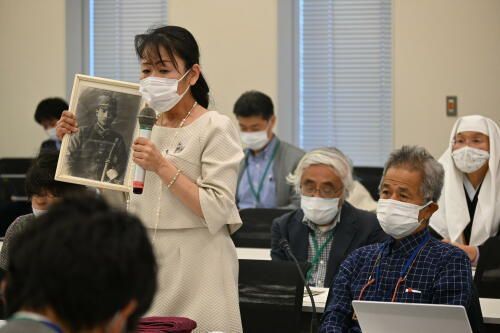
April 22, 2021 Ryukyu Shimpo
There is currently a plan to use soil from the southern part of Okinawa Island, where the Battle of Okinawa was fought, in the construction of the Futenma Replacement Facility (FRF) in Henoko, Nago City. As concerns this plan, on April 21 Takamatsu Gushiken of the volunteer group “Gamafuya” for recovering the remains of war dead participated in a meeting at the National Diet for the first time with personnel from the Ministry of Defense (MOD) and the Ministry of Health, Labour and Welfare (MHLW), and requested suspension of this plan. Gushiken emphatically said, “The Ministry of Defense is making a huge mistake,” and again urged that the plan be abandoned.
Also attending the meeting were an army soldier who fought in the Battle of Okinawa, and Wakako Yonemoto from Chiba Prefecture, who is a 25-year-old family member of a Japanese soldier who died in the Battle. Yonemoto mentioned that her grandfather’s remains have not yet been found, and said, “My grandfather is certainly in Okinawa. It will be as though he was killed three times over: killed in battle, killed by the digging contractors, and submerged in the sea in Henoko.”
Gushiken said, directed at the MHLW, that he hope for a return to the standpoint of accomplishing essential operations, and requested that the MHLW put pressure on the MOD to suspend the plan. The MHLW, together with the Okinawa prefectural government, has jurisdiction over projects for recovering the remains of soldiers fallen in the Battle of Okinawa. In response to Gushiken, a representative of the MOD repeated the opinion the MOD has held to this point, which is “We have not decided on soil procurement sites, including options within the prefecture and outside the prefecture.” A representative of the MHLW simply said, “As concerns recovering the remains of fallen soldiers, we want to devise a solution while observing the wishes of their families.”
(English translation by T&CT and Erin Jones)
Go to Japanese
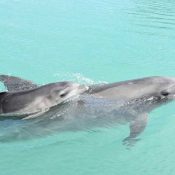
April 22, 2021 Ryukyu Shimpo
On April 21, a bottlenose dolphin was born at Motobu Genki Village in Hamamoto, Motobu. It has been 2 years since a baby dolphin was born there. The birth was the result of artificial insemination. The father is a dolphin named Luster at the Kagoshima City Aquarium in Shiga prefecture.
The baby dolphin was born at approximately 2:10 p.m. At approximately 5:00 p.m., the baby dolphin was seen swimming around in the outdoor pool, staying right next to the mother, Leo.
Veterinarian Keiko Yamamoto was thrilled. “When the dolphin wasn’t born on the expected delivery date, I was worried. I’m relieved the baby was born safely.” (Motobu)
(English translation by T&CT and Ellen Huntley)
Go to Japanese
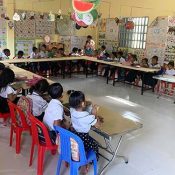
April 22, 2021 Ryukyu Shimpo
Okinawa – Asia Child Support (ACS, Tetsuo Ikema, Director), a non-profit organization based in Okinawa City, recently opened a preschool in Okinawa. Construction was delayed due to the Covid-19 pandemic; however, the school was able to start welcoming students in earnest in February.
The newly opened preschool is in the village of Phnom Touch, about a two-hour drive from Cambodia’s capital, Phnom Penh. There are still landmines buried in the ground from the civil war, making it difficult for the children to play outside. Previously, the children from the farming families in the area had been going to a Buddhist temple.
The preschool was built using supporter’s donations and organization membership fees. This is the third preschool built by ACS in Cambodia. The organization built a total of 112 preschools and schools in various countries.
ACS section manager Naoki Miyaguni commented, “This is a necessary institution for protecting the lives of these children. The school is able to accept the 70-80 children currently living here and in the surrounding villages. There are many parents who travel to the city for work, and I think this will help to ease their minds.”
(English translation by T&CT and Sam Grieb)
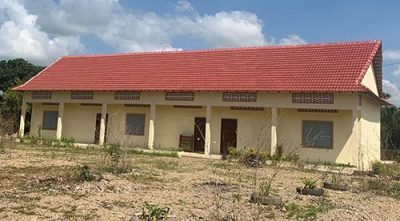
The newly constructed preschool building in Cambodia (photograph provided by Asia Child Support)
Go to Japanese
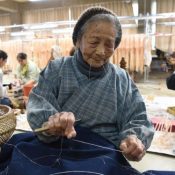
April 23, 2021 Ryukyu Shimpo
The Bashofu Orimono Kobou in Ogimi Village, Okinawa, an artisan textile studio specialized in the traditional Okinawan bashofu fabric, was awarded the 14th Kurashiki Mingeikan Award. The Kurashiki Mingeikan, a folk art museum located in Kurashiki City, Okayama Prefecture, recognizes individuals and groups expected to play an active role in the future of folk art. The Bashofu Orimono Kobou is organized by living national treasure, Toshiko Taira, 100. The Kurashiki Mingeikan will hold an award ceremony and a special exhibition, “The other bashofu story: The work of the Bashofu Orimono Kobou,” on April 24.
Taira met Soichiro Ohara, president of the Kurashiki Boseki textile company, during her stay in Kurashiki as a member of the WWII Teishin women’s corps. After the war, Taira studied weaving. She also built rapport with Kichinosuke Tonomura, the first director of the Kurashiki Mingeikan museum. Both men wished for Taira to preserve and develop Okinawan textiles upon her return to Okinawa. Taira says their words moved her and has been the driving force behind her work with bashofu.
Bashofu Orimono Kobou received the award not only for producing the traditional fabric but also for spreading the folk art through workshops. Taira commented, “The Mingei Association and others supported me with their [encouraging] words. I am grateful for this award.”
(English translation by T&CT and Monica Shingaki)
Go to Japanese
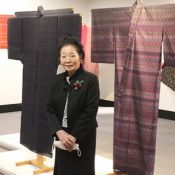
April 20, 2021 Ryukyu Shimpo
By Yoko Takaesu
Aspiring to bring back the beautiful culture of clothing and accessories from the Ryukyu Kingdom era, Kyoko Shukumine, age 84, textile master of Shuri, is working to reproduce clothing, sashes, and other textile arts from the end of the Ryukyu Kingdom era. Many Ryukyu/Okinawa textile arts were lost during the Battle of Okinawa. Shukumine has for many years studied and researched the Ryukyu textile arts kept at the Ethnological Museum of Berlin in Germany and reproduced the techniques of these textile arts. The bold patterns and brilliant colors are eye-catching. She will be displaying around 90 pieces, including 12 pieces of reproduced clothing, at a textile arts exhibit at the Naha Civic Gallery from April 20 to 25.
This is a rare opportunity to view reproduced works of clothing from the Ryukyu Kingdom era all in the same place. Shukumine is a craftsperson specializing in “authentic Shuri textiles,” an Intangible Cultural Property designated by Okinawa Prefecture, and has also been involved in research and education at the Okinawa Prefectural University of Arts. This is her first time opening an individual exhibit in Okinawa.
It was in 1884, after the Ryukyu Disposition (annexation; 1879), that Ryukyu arts and craft works traveled to Germany. At the time, the then-director of the Ethnological Museum of Berlin, who was well-versed in Ryukyu arts and craft works, feared the disappearance of the traditional culture as modernity progressed and collected and stored Ryukyu arts and craft works via the German Embassy in Japan.
Shukumine visited Germany twice, in the early 1990s and in 2012, to spend time at the museum and research 117 pieces of textile arts from the Ryukyu Kingdom era. She used a magnifying glass to count the number of threads in the fabric, studied the combination of warp and weft threads, and drew design sketches.
Through her meticulous research, Shukumine discovered unique coloring born from certain combinations of warp and weft threads. The tonality resulting from weaving a blue weft with a red warp creates a color similar to lavender or grapes. “This color can’t be created with paints. The process of creating colors while building experience is delightful,” she said. Regarding pattern, present-day hanaori weaving uses “small patterns,” while that from the monarchic era incorporated large, bold patterns.
The reproduced works are given imaginative names like “Indigo Silk Hanakura Garment–Coral Reef in Summer” and “Silk Red Hanaori Garment–Color of Passion.” An elegant tapestry made using techniques such as hanaori and kasuri is also on display and is not to be missed.
(English translation by T&CT and Sandi Aritza)
Go to Japanese
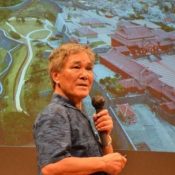
April 18, 2021 Ryukyu Shimpo
The Palette Kumoji 30th anniversary lecture series took place at the Palette Civic Theater in Naha April 17, and University of the Ryukyus emeritus professor and historian Kurayoshi Takara gave a lecture titled “Shuri Castle, now and in the past.” Takara said, “The restoration of Shuri Castle is a central aspect to resurrecting the culture and activity built by our ancestors,” and spoke about his thoughts on the restoration effort, which he has been passionate about over the past 30 years.
Shuri Castle’s main temple and principal facilities were destroyed in a fire in October, 2019, and Takara has been serving as the chairman of Japan’s “Shuri Castle restoration engineering investigation committee.” He explained the “Reiwa era restoration” schedule to have the main temple rebuilt by 2025, and the state of the discussion surrounding it, saying “We have to somehow resolve the contradiction of enacting a thorough policy to prevent another fire or disaster, without destroying the traditional wooden architecture. We are in the course of combining our knowledge while continuing to investigate the issue.”
While looking back on the previous restoration of the Castle, which was destroyed during the Battle of Okinawa he introduced an idea to collect and preserve the cultural and history materials of the Ryukyu Kingdom that have been scattered both to other areas of Japan and abroad. “We have not historical records, and a building that has not been rebuilt. Shuri Castle is unfinished, and there is still a lot of work to do. I want the next generation to work at the restoration with new investigative research and information gathering.”
(English translation by T&CT and Sam Grieb)
Go to Japanese
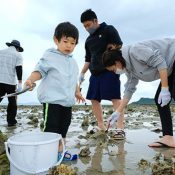
April 15, 2021 Ryukyu Shimpo
Hamauri, which is the third day of the third month in the traditional lunar calendar and landed on April 14 this year, families all over Okinawa could be seen enjoying themselves down at the beach digging for shellfish at low tide. Around the mid-sea road in Yonaguni, Uruma low tide came in the afternoon, and the cheers of children could be heard as they searched for seaweed and things that live in the ocean. Mami Hanaki, 49, who was searching for shellfish with a group of family and friends said smiling, “It was cloudy so not too hot, making for great weather. Everyone seemed to be enjoying themselves.”
Hamauri is an annual event that is observed in the Amami and Okinawa regions. People head down to the beach to soak their hands and feet and pray for good health.
(English translation by T&CT and Sam Grieb)
Go to Japanese
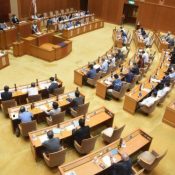
April 16, 2021 Ryukyu Shimpo
On April 15, the prefectural assembly (chaired by Noboru Akamine) opened an extraordinary meeting and unanimously passed a written opinion to request that soil, in which are mixed the remains of the war dead from the Battle of Okinawa, not be used in land reclamation work. The written opinion contains the request: “Do not use, for land reclamation, soil in which are mixed the remains of war dead from the tragic Battle of Okinawa.”
Governor Denny Tamaki set April 16 as the day he would announce his response to a contractor planning to dig up soil in Komesu, Itoman City. He has considered issuing an administrative order, but it seems unlikely that he will go as far as a suspension order that would prohibit the digging.
In response to the written opinion being passed, Governor Tamaki said “I intend to give weight to the wishes of the assembly.” The Okinawa prefectural government has yet to make a declaration in response to the written opinion.
On the evening of April 15, to representatives of the ruling party in the prefectural assembly, Governor Tamaki and his colleagues explained their plan to issue an administrative order. The plan initially presented by the prefectural assembly was a “necessary measures” order, which is the most lenient of administrative orders. When remains were found, it was proposed that suitable coordination be carried out with concerned parties. The ruling party of the assembly strongly opposes this proposal and requests that a stronger administrative order be used in response to the decision by the central government. The OPG has begun to reconsider after receiving the ruling party’s request. As a general rule, the issuing of an administrative order should take place within 30 days of notification by the contractor.
The written opinion is addressed to the prime minister, the minister of defense, and the members of both house of the Diet. The proposal in this written opinion came about due to the plan to use soil from the southern part of Okinawa Island, potentially containing human remains, in the construction of the Futenma Replacement Facility in Henoko. The unanimous goal of the ruling party of the prefectural assembly is to keep the southern part of the island from being a soil collection site. The wording “Henoko” was not incorporated in the written opinion as the site for use of collected soil.
There is a possibility that soil for use in construction of the FRF in Henoko will be hauled out from the southern part of Okinawa Island, where there are remains of the war dead from the Battle of Okinawa. Governor Tamaki is being asked to issue a suspension order against the digging. There are various levels to this endeavor, such as prohibiting or restricting actions by means of administrative order and requesting necessary measures for environmental protection.
Takamatsu Gushiken, representative of the volunteer group “Gamafuya” for recovering the remains of war dead, made a plan to hold a gathering at noon on April 16 in front of the Prefectural Office to request that Governor Tamaki issue a suspension order to the contractor. In March of this year Takamatsu Gushiken went on a hunger strike, demanding, among other things, that (1) the Japanese government abandon the plan to use soil from the southern region and (2) the Okinawa prefectural government issue a suspension order.
(English translation by T&CT and Erin Jones)
Go to Japanese
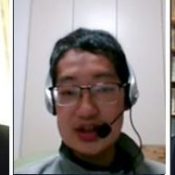
April 14, 2021 Ryukyu Shimpo
Three university students started Urgent Action (Kinkyu Action), a public pressure campaign on the Japanese government to block a soil collecting project in southern Okinawa, where remains of the war dead from the Battle of Okinawa lay. Additionally, the campaign rallies support for Governor Denny Tamaki’s response against the mining contractor, which submitted a permit to operate in Itoman City.
The three originators of Urgent Action are Keigo Nishio, 22, a student at Yale University in the U.S.; Yuto Ishikawa, 22, and Kazu Nakamoto, 21, graduate students at Okinawa International University.
The Okinawa prefectural government is currently reviewing legal options to block the contractor, which submitted a permit to operate in Yonesu, Itoman City. The trio is urging the public at large to send letters to the Japanese government to stop the sand and soil collection in the southern city, and to encourage Governor Tamaki to make the “right decision” in dealing with the contractor by the April 16 deadline.
Nishio asked for broad public support as he emphasized, “[The situation] is being framed as a prefectural conflict between the Okinawan government and the contractor. But the most consequential party is the national government, and the victims are the war dead and their bereaved families.”
(English translation by T&CT and Monica Shingaki)
Go to Japanese
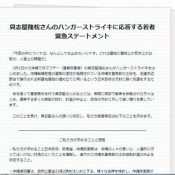
March 10, 2021 Ryukyu Shimpo
On March 6, an urgent youth statement in support of Takamatsu Gushiken’s hunger strike and calling on the Japanese government to halt plans to obtain soil from the southern part of Okinawa Island was published online by a group of young people in their twenties both in and outside of Okinawa prefecture. Gushiken is a representative of the Gamafuya, a group of volunteers who search for the remains of war dead from the Battle of Okinawa. Gushiken went on a hunger strike to call on the government to abandon its plans of obtaining soil from the southern part of Okinawa Island, where there are remains of the war dead, for use in the construction of the new military base at Henoko. People who support the youth statement can add their signature at the site where the statement was posted. As of March 9, 60 students and other young people in and outside of Okinawa had added their signatures.
Six individuals have signed on as promoters of the statement, including Jinshiro Motoyama, former representative of the Henoko Kenmin Tohyo no Kai (the Group for the Henoko Prefectural Referendum) and a doctoral student at Hitotsubashi University’s Graduate School of Law, and Yuto Ishikawa, a fourth-year student at Okinawa International University who is working to record and inherit the legacy of the Battle of Okinawa. Two-thirds of supporters are young people outside of Okinawa.
The statement calls on the Japanese government and other groups to halt plans to obtain soil from the southern part of Okinawa Island, and for the governor of Okinawa to halt plans and consider placing limitations on such activity. The statement further asserts that the issue relates to how Japan has dealt with the aftermath of the war, and to democracy itself, and thus that every single person in Japan should learn about and discuss the issue with the awareness that it directly concerns them.
Keigo Nishio, from Ibaraki, Osaka, is also among the statement promoters. He supports the work of those gathering the remains of the dead from the Battle of Okinawa, and proposed the idea of publishing the statement. He spoke with Ishikawa, who he met through work related to peace education, and made the statement a reality. Nishio says, “I saw how Mr. Gushiken was risking his life to bring attention to this problem, and was very moved. I wanted to figure out what I could do as someone from the main islands of Japan. I wanted to answer his call.” Ishikawa says, “My goal is for more people to understand the feelings of the bereaved, and to create a space where Okinawans and people from the rest of Japan can think about these issues together.” They plan to host a talk on Zoom in the near future.
(English translation by T&CT and Ellen Huntley)
Go to Japanese
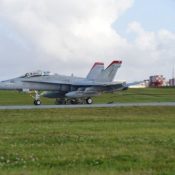
April 13, 2021 Ryukyu Shimpo
On the evening of April 12, exactly 25 years after the agreement was made to completely close U.S. Marine Corps Air Station (MCAS) Futenma in 1996, four FA18 combat jets from MCAS Iwakuni in Yamaguchi Prefecture arrived one after another to MCAS Futenma, exposing the surrounding cities and towns to explosive noise. Their training continued into the night. Though a quarter of a century has passed since the return agreement, there is no change in the reality of U.S. military aircraft flights causing harm to surrounding residents, and the severity of the situation only continues to increase.
According to the Okinawa Prefectural Government, noise of 115.8 decibels was recorded at 5:30 p.m. in the Ueojana area of Ginowan. 110 decibels is equivalent to the sound of a vehicle alarm heard up close, and 120 decibels is considered to be near the limit of a human’s hearing capacity.
On the evening of April 12, U.S. Marine troops stationed in Okinawa revealed details of their training at MCAS Futenma to the Ryukyu Shimpo and others. When asked why the training was carried out on April 12, James Pryor, commanding officer of the Marine Wing Support Squadron 172, who responded to the request for an interview, stated that the training was part of training carried out in various locations, and just happened to be scheduled for MCAS Futenma on that day. Regarding the noise, he said that the Marines intend to carry out their training with consideration to the balance between readiness and the concerns of residents.
The flights were part of training related to the strategic concept of EABO (Expeditionary Advanced Base Operations) in which temporary bases for resupply and attacks are stationed on remote islands and the like. The training on April 12 was carried out assuming scenarios such as a short runway, and involved a wire being attached to the planes so that they could make a short-distance landing and then take off once more. Related training will continue until April 17.
(English translation by T&CT and Sandi Aritza)
Go to Japanese












 Webcam(Kokusai Street)
Webcam(Kokusai Street)


